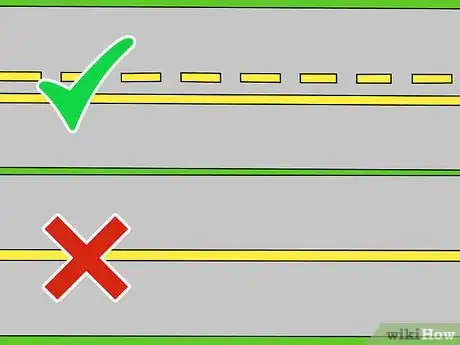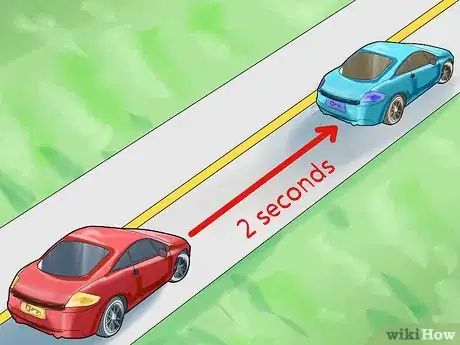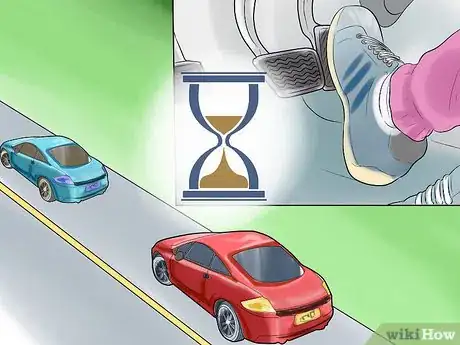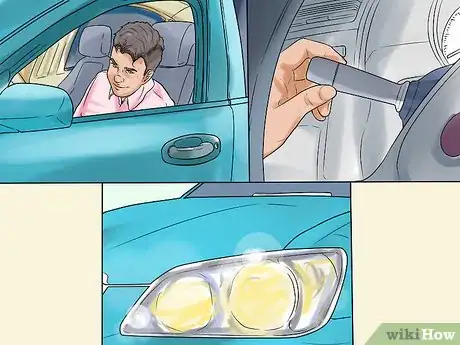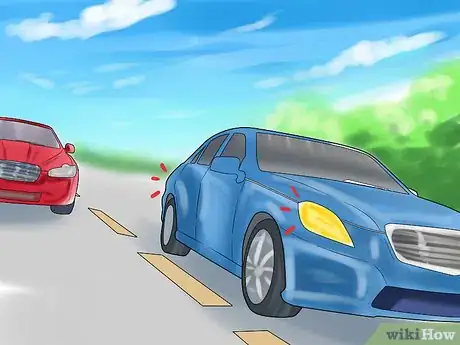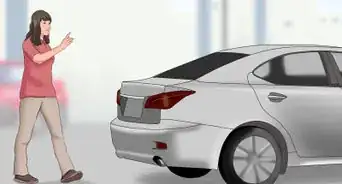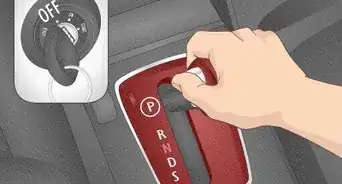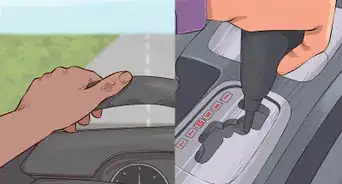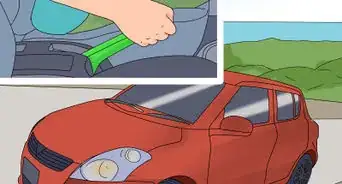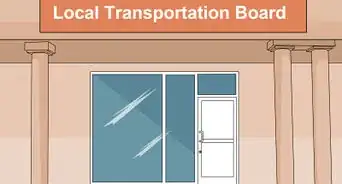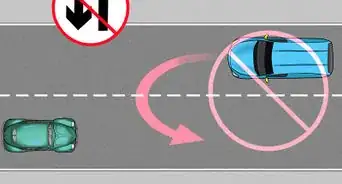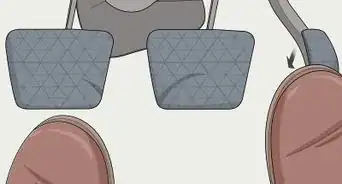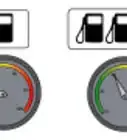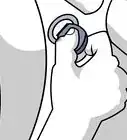This article was co-authored by Bruce Storrs. Bruce Storrs is a Driving Instructor and the President & CEO of North County School of Driving in San Marcos, California. With more than 31 years of experience, he specializes in teaching teens and adults safe driving behaviors in the classroom, online, and behind the wheel. Bruce earned a BA and MA from San Diego State University.
This article has been viewed 121,642 times.
It can be frustrating to get behind a slow moving car on a two-lane road, and it's a tricky maneuver to pass them. While it can be a dangerous move if you don't appropriately follow the rules of the road, being aware of all your surroundings and moving with precaution can ensure a safe transition to get in front of the vehicle.
Steps
Checking Your Surroundings
-
1Look at traffic signals and lane markings to ensure passing is legal. Check for signs indicating whether you're in a designated passing zone or non-passing zone. If you're unsure, look at the lane markers.[1]
- A solid yellow line indicates it's unsafe to pass into oncoming traffic.
- A single dotted yellow line or a solid yellow line with a dotted line on your side of traffic indicates that it's a safe move.
-
2Evaluate the conditions. Look around you, and check to be sure that there are no conditions that could prohibit you from making a safe pass. Be aware of upcoming hills or curves, traffic stop signs or lights, and train tracks.[2]
- Tunnels, bridges and viaducts can obstruct your view. If you see any up ahead, wait until you have passed them to consider a move.
- Do not attempt to pass a slow moving car if you're driving on a hill or curve because you'll have limited vision. Wait for a long stretch of flat road.
- Be aware of driveways and other entrances where cars may unexpectedly come from.
- If the weather is rainy, foggy or snowy, consider staying in your lane as these types of conditions can cause you to slip or they can make it more challenging to see ahead.
- Check your surroundings for animals, like deer, that can run into the middle of the road.
Advertisement -
3Check surrounding traffic. Look ahead to the other lane, and notice traffic following behind you, and check for vehicles in front of the one you plan to pass.[3]
- Establish there is no oncoming traffic that will come within 200 feet (0.061 km) of you in the passing lane. Do not pass if you can't see .25 miles (0.40 km) ahead.
- Look at your rear-view and side mirrors for traffic coming from behind you right before you move into the opposite lane to pass. Then check for oncoming traffic once again.
-
4Ensure you can pass without going over the speed limit. It can be frustrating to be behind someone driving slow, but if they are driving less than 15 miles (24 km) under the speed limit, it may be best to stay put.[4]
- You'll have to increase your speed up to 20 miles (32 km) to pass, so be sure you're aware of the speed limit where you are.
- Be aware that speed limits can drop dramatically, up to 30 miles (48 km), along some country roads upon arriving in a town.
-
5Have a backup plan. Ensure that you have enough space between the vehicle in front of you and any behind you so that you have an opening if you need get back into your lane without passing.
- Use the two-second rule. Count one thousand one, one thousand two after the car in front of you has passed a marker of some kind to be sure you have enough space. A sign, tree or lamppost works as a marker.
Moving Past a Vehicle Safely
-
1Accelerate slowly. Give yourself at least one vehicle length distance between the front end of your car and the back end of the one you're passing.
- Avoid being aggressive with your speed and give yourself plenty of time and space between the vehicle. Don't slam on the gas to safely arrive in front of the slow car.
-
2Use your turn signal. Alert the slow driver of your maneuver by using your turn signal. look over your shoulder and check your mirrors as you start to make a pass.
-
3Smoothly pass over the dotted lane marker. Look ahead to be sure there is still no traffic coming up ahead. If it's safe, swiftly accelerate to a speed that does not exceed the speed limit. You should be able to make the maneuver in roughly 15 seconds.
-
4Quickly pass the vehicle. Glance at both your side and rear-view mirrors to determine the position of the vehicle you just passed.
- Always keep an eye on the vehicle you're passing to be sure they don't speed up or move in an unexpected way.
- Keep both hands on the wheel the whole time.
- Be on alert.
-
5Signal your re-entry to the appropriate lane. Put on your turn signal after moving about two car lengths in front of the vehicle you are passing.
- Smoothly cross back into the lane.
- Maintain your desired speed without exceeding the limit.
- Glance in your rear-view to check the distance of yourself and the car you passed.
Expert Q&A
-
QuestionHow do I avoid oncoming traffic?
 Bruce StorrsBruce Storrs is a Driving Instructor and the President & CEO of North County School of Driving in San Marcos, California. With more than 31 years of experience, he specializes in teaching teens and adults safe driving behaviors in the classroom, online, and behind the wheel. Bruce earned a BA and MA from San Diego State University.
Bruce StorrsBruce Storrs is a Driving Instructor and the President & CEO of North County School of Driving in San Marcos, California. With more than 31 years of experience, he specializes in teaching teens and adults safe driving behaviors in the classroom, online, and behind the wheel. Bruce earned a BA and MA from San Diego State University.
Driving Instructor You must be careful and have a full view of the road before passing, especially if you're on a two-way road. Also, if you have an oncoming car that's coming towards you that appears out of nowhere, you're to slow down, pull back and behind the car you're trying to pass and wait until it's safe again.
You must be careful and have a full view of the road before passing, especially if you're on a two-way road. Also, if you have an oncoming car that's coming towards you that appears out of nowhere, you're to slow down, pull back and behind the car you're trying to pass and wait until it's safe again. -
QuestionCan I pass more than one vehicle?
 Community AnswerYou can, but it is not recommended if you are on a road where the other lane is travelling in the opposite direction.
Community AnswerYou can, but it is not recommended if you are on a road where the other lane is travelling in the opposite direction. -
QuestionOn two way roads, should we not pass?
 Community AnswerYou can pass, but you have to make sure there are no cars coming in the other lane, and that the road is zoned for passing.
Community AnswerYou can pass, but you have to make sure there are no cars coming in the other lane, and that the road is zoned for passing.
Warnings
- Never pass a vehicle if your vision is impaired by other vehicles, curves or hills.⧼thumbs_response⧽
- If a vehicle in front of you has been traveling at a steady speed then suddenly slows down, stay in your lane and reevaluate the move.⧼thumbs_response⧽
- Be especially mindful of weather, including high winds, which could make it more challenging to pass safely.⧼thumbs_response⧽
- Take extra care when you are in a motorized vehicle passing a bicycle or motorcycle. Never move into the same lane as a bicycle or motorcycle even if the lanes are wide and the smaller vehicle is to the side.⧼thumbs_response⧽
- Always be ready for unexpected moves from fellow drivers.⧼thumbs_response⧽
- If you're following a vehicle that is being operated irrationally, such as one that refuses to let you pass and then drives very slowly, it is best to fall back in traffic. Call the authorities if you feel your life is in danger.⧼thumbs_response⧽
References
- ↑ https://www.dmv.ca.gov/portal/dmv/detail/pubs/hdbk/traffic_lanes
- ↑ http://www.mlive.com/news/grand-rapids/index.ssf/2016/05/ask_a_trooper_pass_safely_on_t.html
- ↑ http://safeny.ny.gov/roadrule.htm
- ↑ http://www.driversedguru.com/drivers-ed-training-exercises/stage-4/stage-4-passing-on-two-lane-roads/
About This Article
If you’re trying to pass safely on a two-lane road, start at least one vehicle length behind the car you’re passing and begin accelerating slowly. Check your mirrors to be sure you’re clear, and put your turn signal on to indicate that you’re changing lanes. Then, accelerate quickly as you move into the passing lane, but be sure you’re not exceeding the posted speed limit. When you can see in your side and rear-view mirrors that you’re about two vehicle lengths in front of the car you’re passing, put your turn signal on and move back into the driving lane. To learn how to read lane markings and traffic signals to be sure you’re in a passing zone, scroll down!
